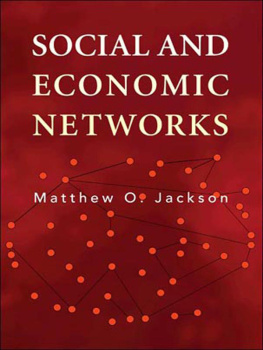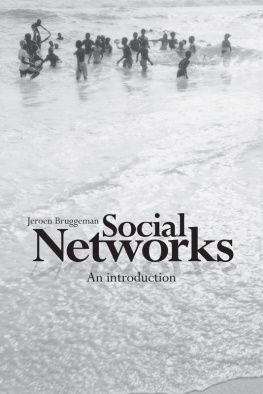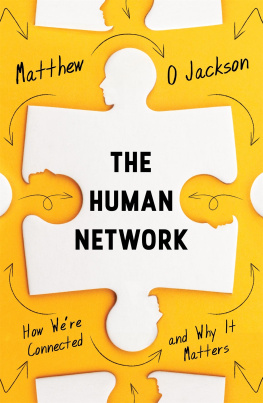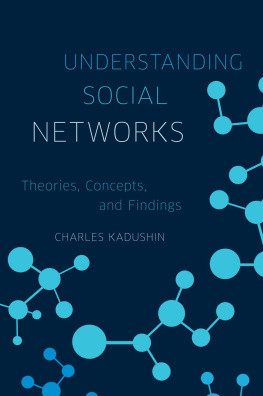Jackson - Social and Economic Networks
Here you can read online Jackson - Social and Economic Networks full text of the book (entire story) in english for free. Download pdf and epub, get meaning, cover and reviews about this ebook. City: Princeton;N.J;Woodstock, year: 2011, publisher: Princeton University Press, genre: Home and family. Description of the work, (preface) as well as reviews are available. Best literature library LitArk.com created for fans of good reading and offers a wide selection of genres:
Romance novel
Science fiction
Adventure
Detective
Science
History
Home and family
Prose
Art
Politics
Computer
Non-fiction
Religion
Business
Children
Humor
Choose a favorite category and find really read worthwhile books. Enjoy immersion in the world of imagination, feel the emotions of the characters or learn something new for yourself, make an fascinating discovery.
- Book:Social and Economic Networks
- Author:
- Publisher:Princeton University Press
- Genre:
- Year:2011
- City:Princeton;N.J;Woodstock
- Rating:3 / 5
- Favourites:Add to favourites
- Your mark:
- 60
- 1
- 2
- 3
- 4
- 5
Social and Economic Networks: summary, description and annotation
We offer to read an annotation, description, summary or preface (depends on what the author of the book "Social and Economic Networks" wrote himself). If you haven't found the necessary information about the book — write in the comments, we will try to find it.
Jackson: author's other books
Who wrote Social and Economic Networks? Find out the surname, the name of the author of the book and a list of all author's works by series.
Social and Economic Networks — read online for free the complete book (whole text) full work
Below is the text of the book, divided by pages. System saving the place of the last page read, allows you to conveniently read the book "Social and Economic Networks" online for free, without having to search again every time where you left off. Put a bookmark, and you can go to the page where you finished reading at any time.
Font size:
Interval:
Bookmark:

Copyright 2008 by Princeton University Press
Requests for permission to reproduce material from this work
should be sent to Permissions, Princeton University Press
Published by Princeton University Press, 41 William Street, Princeton,
New Jersey 08540
In the United Kingdom: Princeton University Press, 6 Oxford Street, Woodstock,
Oxfordshire OX20 1TW
All Rights Reserved
ISBN-13: 978-0-691-13440-6
Library of Congress Control Number: 2008926162
British Library Cataloging-in-Publication Data is available
This book was composed in Times Roman and Slimbach using ZzTEX
by Princeton Editorial Associates, Inc., Scottsdale, Arizona.
Printed on acid-free paper. 
www.press.princeton.edu
Printed in the United States of America
1 3 5 7 9 10 8 6 4 2
To Sara, Emily, and Lisa
This book provides an overview and synthesis of models and techniques for analyzing social and economic networks. It is meant to serve as both a resource for researchers and a text on the subject for graduate students. The focus is primarily on the modeling of and theory behind the structure, formation, and implications of social networks. Statistical and experimental analyses of networks are also discussed throughout, especially when they help set the stage for issues to be investigated. The main emphasis is on providing a foundation for analyzing and understanding social and economic networks.
The book is organized into four parts. The first part introduces network analysis and provides some background on various networks, how they are measured, and useful ways of representing them. The second part presents some of the models that have been used to understand how networks are formed. This part draws on two very different perspectives: random-graph models, for which there is some stochastic process that governs the development of the links in a network, and strategic models of network formation, in which the development of links is based on costs and benefits, and game-theoretic techniques are used. These approaches to modeling provide different insights into networks, how they are formed, and why they exhibit certain characteristics. The third part of the book looks at the implications of network structure. Much of the interest in networks is due to the fact that their structure is an important determinant of how societies and economies function. This part examines how network models are used to predict the spread of disease, the dissemination of information, the behavior of people, and how markets function. The final part of the book covers empirical analyses of networks and methods of identifying social interaction.
Although the table of contents represents a categorization of the chapters by subject, the relationship between the chapters is not entirely linear. I have intermingled some subjects to tie together different approaches, and the chapters are cross referenced. There is also a progression in the book, with some of the more technically demanding chapters coming later, as well as those that draw on concepts from earlier chapters.
The modeling of networks requires some mathematical background, but I have made the book as self-contained as possible. I do not presume any knowledge beyond some familiarity with linear algebra (vectors and matrices), calculus, and probability and statistics. The discussions employing graph theory and game theory are self-contained, and there are appendixes with introductions to some of the topics, including various useful results from graph theory, math, game theory, and probability theory. Those sections and exercises that are more mathematical in nature are marked with an asterisk (*).
I had several reasons for writing this book. First and foremost, networks of relationships play central roles in a wide variety of social, economic, and political interactions. For example, many, if not most, markets do not function as centralized and anonymous institutions, but rather involve a variety of bilateral exchanges or contracts. As a case in point, most jobs are filled by people who were informed about the job through a social contact. This fact has consequences for patterns of employment, inequality in wages across groups, and social mobility. Understanding social network structure and how it influences human interaction is not merely important to science (and the social sciences in particular), it is essential. Second, the topic is timely. Recent technological advances have made information networks much more prominent (e.g., the world wide web), and people are more conscious of the role of networks in their lives. In addition, the formal modeling of networks has now reached a maturity across fields that permits a book-length treatment. A third motivation for writing this work is the inter- and multidisciplinary nature of research on networks: the pertinent knowledge is diffuse, and there is much to be gained by collecting aspects of it from different fields in a unified treatment. Substantial research on networks has been conducted in sociology, economics, physics, mathematics, and computer science, and these disciplines take different approaches and ask varied questions. Thus it is important to bridge the literatures and produce a text that collects and synthesizes different modeling approaches and techniques and makes them all available to researchers from any discipline who are interested in the study of networks.
At the end of each chapter in this book you will find exercises. The exercises are meant to serve several purposes. They serve the usual purpose of problems in a textbook: to give students a chance to work with concepts and more fully familiarize themselves with the ideas presented in the chapter; thus the exercises can be made part of courses. And the interested researcher can work the exercises as well. But the exercises also introduce new material. I have used them to introduce new concepts not covered in the text. These are meant to be closely related to material in the text but complementary to it. Often the ideas were important enough to include in the book, but did not fit easily with the main thread of a chapter without making it longer than I desired or taking us off on a tangent. Thus researchers consulting this book as a reference should not ignore the exercises and in many instances may actually find what they are looking for in them.
As with any such undertaking, there are many acknowledgments due, and they do not adequately represent the scope and depth of the help received. This project would not have been possible without financial support from the Center for Advanced Studies in the Behavioral Sciences, the Guggenheim Foundation, and the Lee Center for Advanced Networking, as well as the National Science Foundation under grants SES-0316493 and SES-0647867. I began this project while I was at the California Institute of Technology and concluded it while at Stanford University, and the support of both institutions is gratefully acknowledged.
As for the content of this monograph, I have been deeply influenced by a number of collaborators. My initial interest in this subject arose through conversations and subsequent research with Asher Wolinsky. I have continued to learn about networks and haved enjoyed interaction with a group of coauthors (in chronological order): Alison Watts, Bhaskar Dutta, Anne van den Nouweland, Toni Calv-Armengol, Francis Bloch, Gary Charness, Alan Kirman, Jernej Copic, Brian Rogers, Dunia Lopez-Pintado, Leeat Yariv, Andrea Galeotti, Sanjeev Goyal, Fernando Vega-Redondo, Ben Golub, Sergio Currarini, and Paolo Pin. Their collaboration and friendship are greatly appreciated.
Font size:
Interval:
Bookmark:
Similar books «Social and Economic Networks»
Look at similar books to Social and Economic Networks. We have selected literature similar in name and meaning in the hope of providing readers with more options to find new, interesting, not yet read works.
Discussion, reviews of the book Social and Economic Networks and just readers' own opinions. Leave your comments, write what you think about the work, its meaning or the main characters. Specify what exactly you liked and what you didn't like, and why you think so.
















